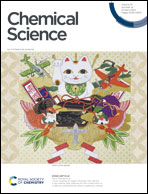Cobalt-catalyzed double hydroboration of pyridines†
Abstract
Cobalt(II) complexes were prepared from a modular phosphinopyridonate platform and applied to the hydroboration of pyridines. The synthetically useful, yet challenging, double hydroboration toward tetrahydropyridine derivatives was successfully performed with high activity and regiocontrol. This new method enabled the direct synthesis of N-heterocyclic allylic boronates from commercial pyridines and pinacolborane (HBpin). One-pot acetylation afforded the bench-stable borylated N-acetyl tetrahydropyridines in good yields. The synthetic utility of this procedure was demonstrated by a gram-scale double hydroboration–acetylation sequence followed by chemical diversification. Mechanistic experiments indicated metal–ligand cooperativity involving ligand-centered C–H activation and the intermediacy of a cobalt(III) hydride species.



 Please wait while we load your content...
Please wait while we load your content...